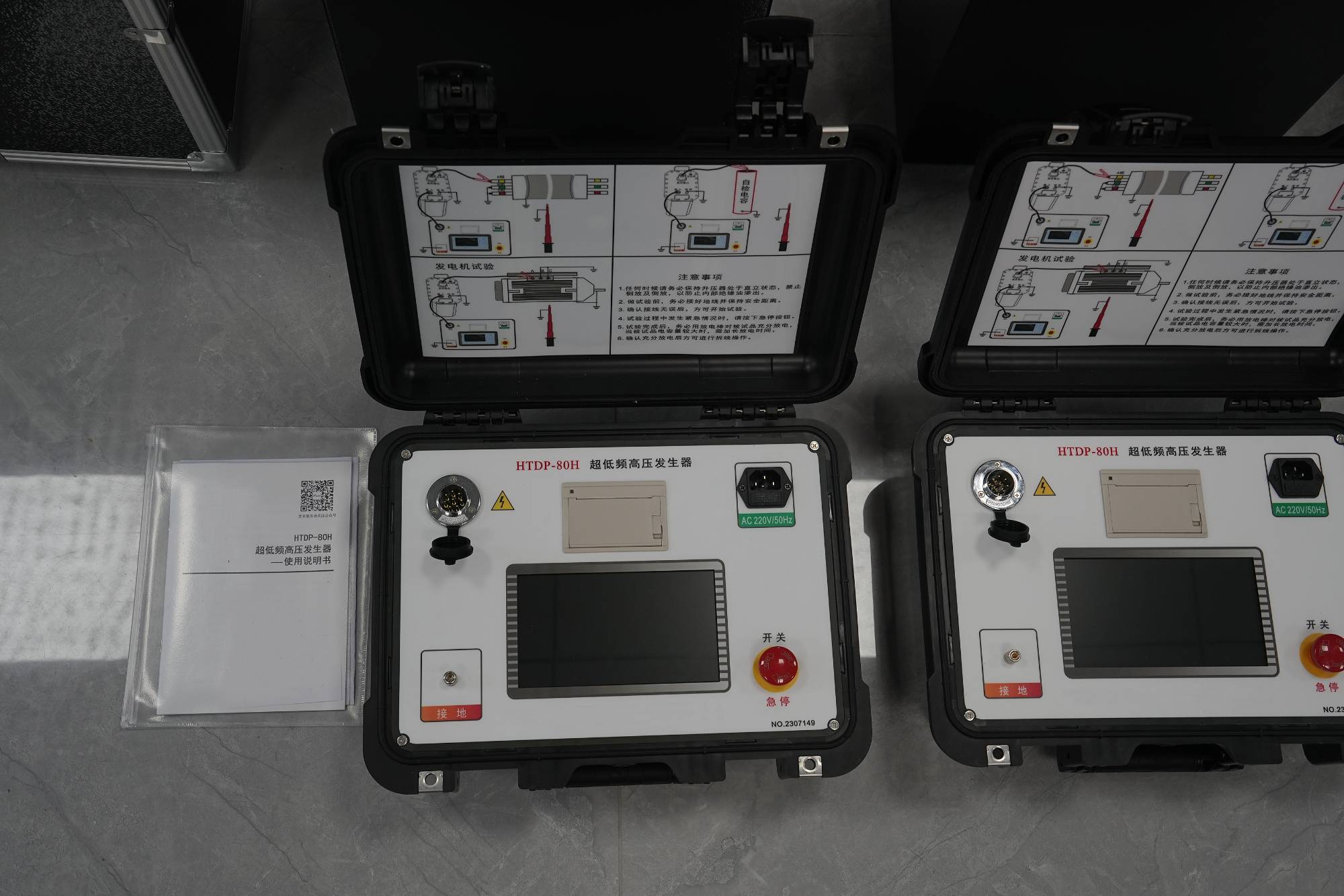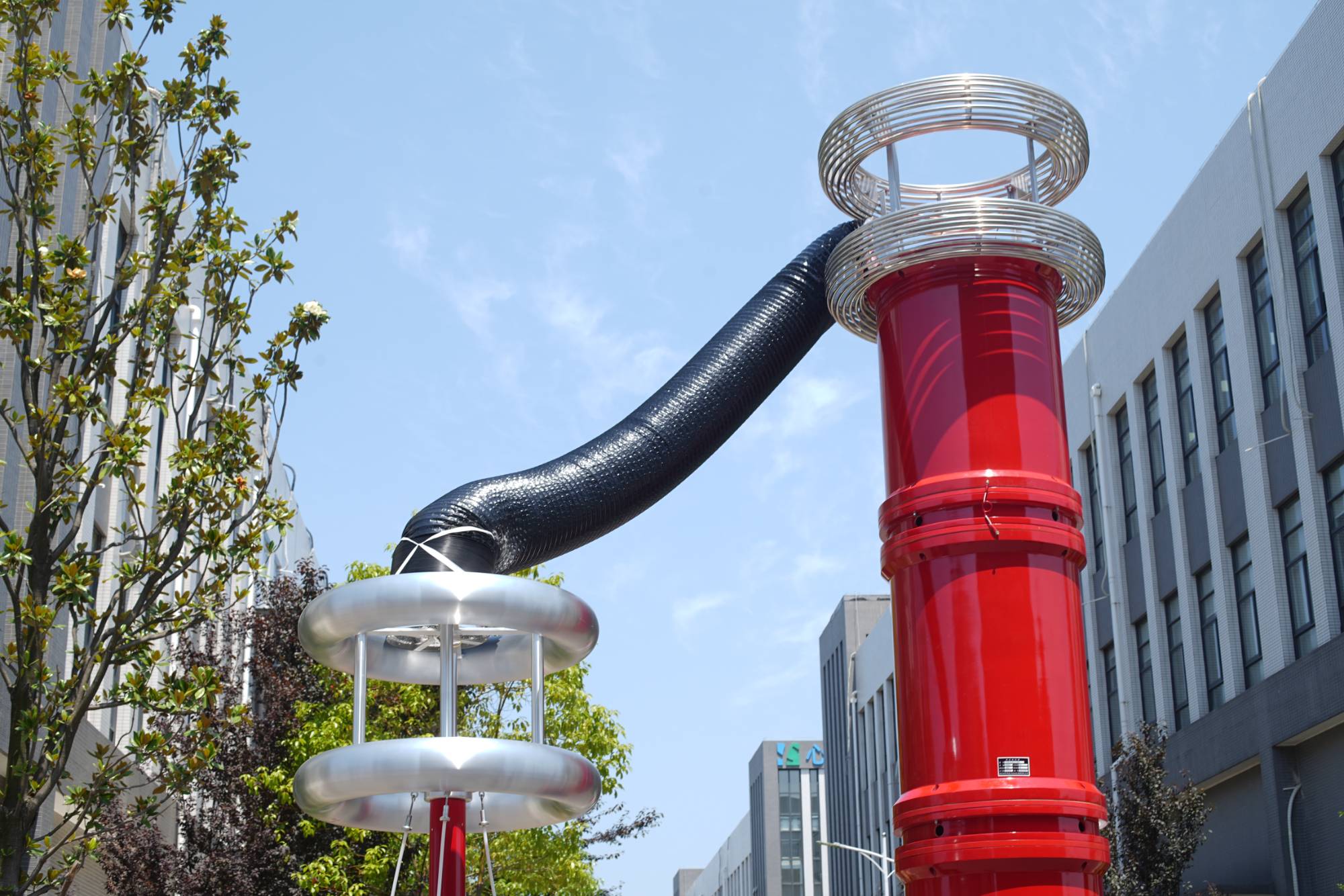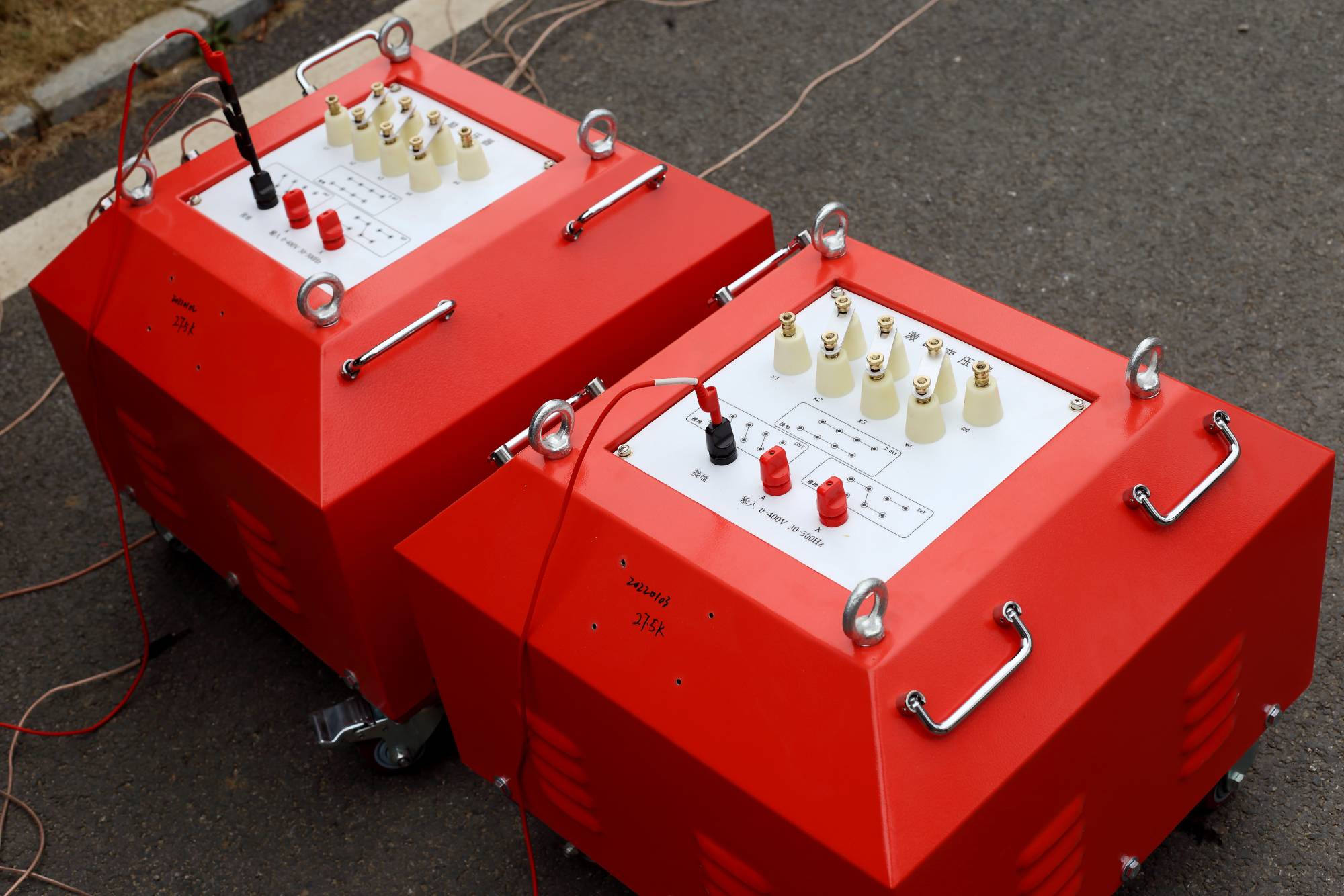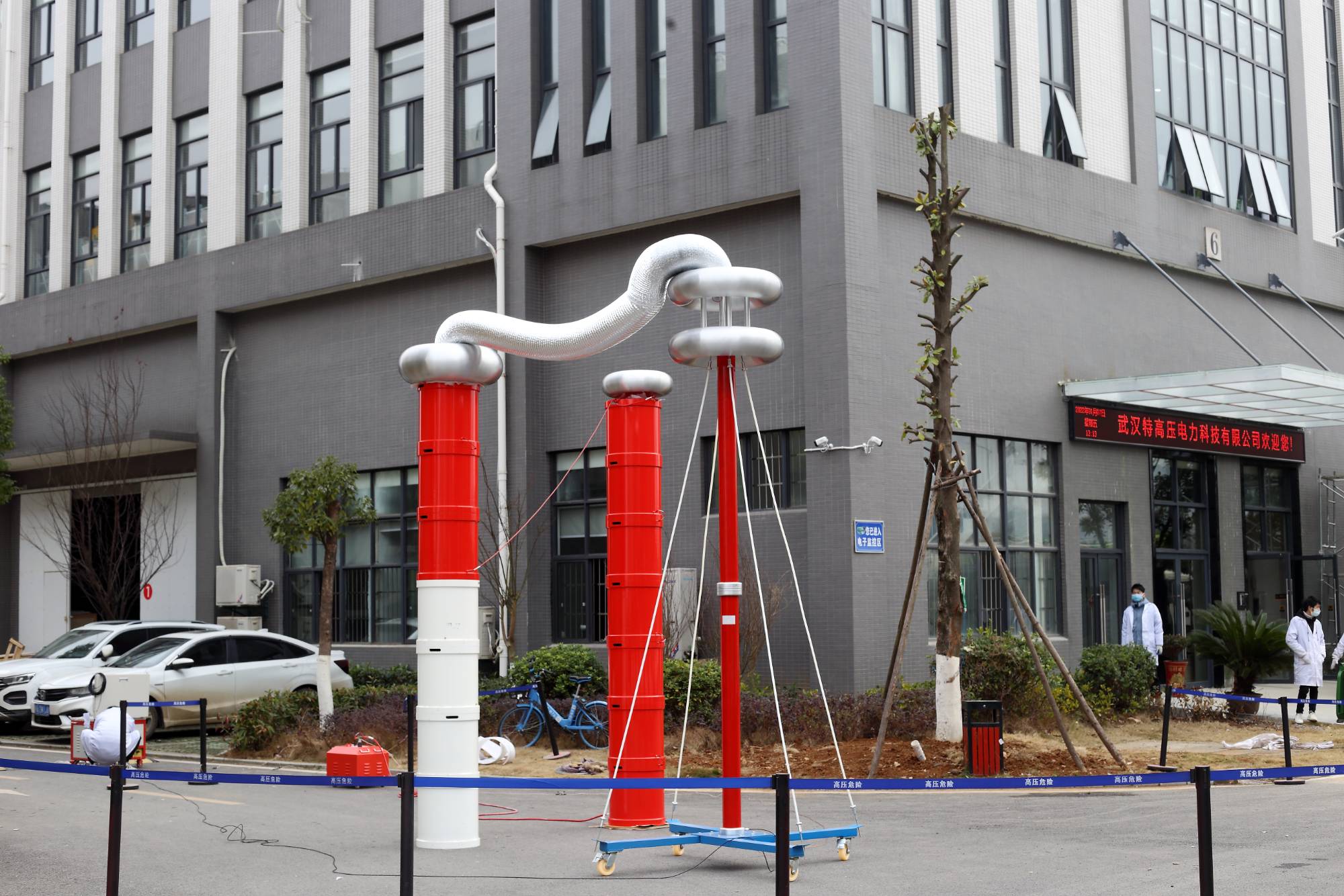Product List
Contact Us
Email:qiao@hvtest.cc
Mobile:+8615871365102
What's app:+8615871365102
-

Resonance frequency of series resonance
2025-09-24Voltage resonance phenomenon is observed in a series resonant circuit composed of capacitors, inductors, and resistors. In order to ensure the energy supply of the resonant circuit, the series circuit also includes an electromotive force source E, which generates an alternating voltage with a frequency of W. During resonance, the circulating current in the series circuit must be in phase with the electromotive force. If only the total resistance of circuit Z=R+J (WL-1/W C) is activated, it ensures effective Z=R. Equality:(L-1 /WС)= 0(1)It is the mathematical condition for resonance in a resonant circuit. In this case, the current in the circuit will be I=E/R. If we transform equation (1), we obtain:WL = 1 /WС。In this expression, W is the resonant frequency of the circuit.Importantly, during the resonance process, the voltage across the inductor is equal to the voltage across the capacitor, and is:UL = U = WL * I = WLE / R The total amount of energy in inductance and capacitance (magnet
MORE -

Precautions for the Use and Maintenance of VLF hipot tester
2025-09-23The VLF hipot tester is integrated with modern digital frequency conversion technology, using microcomputer control to boost, buck, measure, protect, automate, and can be manually intervened during the automatic boost process. Due to its full electronicization, this instrument is small in size and light in weight, with a large screen LCD display that is clear and intuitive. It can also display output waveforms and print test reports.1. Before using the instrument, first observe whether the appearance of the instrument is damaged. After powering on, check if the instrument head displays properly and if the display is complete. For instruments that have not been used for a long time, check if the output terminal is corroded or aged. Otherwise, they should be cleaned up in a timely manner before use. Please refer to the "Usage Operation" method when using.2. The VLF hipot tester is a precision electronic instrument that cannot be opened arbitrarily. When opening it, we must take relevant
MORE -

What are the specific application scenarios of 0.1Hz VLF hipot tester in power equipment testing?
2025-09-23The VLF hipot tester under Wuhan UHV can help many power workers conduct various power tests more conveniently.The 0.1Hz VLF hipot tester has a wide range of application scenarios in power equipment testing, mainly including:1. Voltage withstand test of power cables: Suitable for non-destructive insulation voltage withstand test of plastic power cables such as PE/XLPE, which are crucial for testing the insulation performance of the cables.2. Testing of large high-voltage rotating electrical machines: used for voltage withstand testing of large generators and motors to ensure the integrity and reliability of their insulation systems.3. Testing of power capacitors: Conduct AC withstand voltage tests on power capacitors to evaluate their insulation strength.4. On site voltage withstand test: Due to its small size and light weight, the 0.1Hz VLF hipot tester is very suitable for outdoor on-site testing, making it convenient to test the equipment in different locations.5. Preventive testing
MORE -

What equipment is primarily tested using a VLF hipot tester?
2025-09-23A VLF hipot tester is a crucial piece of equipment for high-voltage electrical testing.Its primary purpose is to substitute power frequency (50Hz/60Hz) high voltage for withstand tests, especially suited for electrical equipment with very large capacitance. For equipment with large capacitance, using traditional power-frequency test transformers for withstand voltage testing requires very large and heavy power supplies and transformers, which are highly inconvenient for field use.In simple terms, a VLF hipot tester is mainly used to test the insulation strength of power equipment with significant ground capacitance.The following are the most common types of equipment tested with VLF hipot testers:1. Power Cables (This is the most common and primary application)Types: Including cross-linked polyethylene (XLPE) cables, polyethylene (PE) cables, polyvinyl chloride (PVC) cables, rubber-plastic insulated cables, etc., covering medium-voltage cables from 6kV to 35kV and even higher voltage l
MORE -

Working principle and application fields of VLF hipot tester
2025-09-23The VLF hipot tester under Wuhan UHV can help many power workers conduct various power tests more conveniently.1、 Working principleThe basic working principle of VLF hipot tester is to use the electromagnetic induction effect of high voltage transformer to convert low voltage alternating current into high voltage direct current. The workflow is as follows:1. The low-voltage AC power supply enters the high-voltage transformer, and through the electromagnetic induction effect of the transformer, the voltage gradually increases from low to high.2. Convert the AC power output by the transformer into stable DC power through circuits such as rectification and filtering.3. Part of the high-voltage direct current is divided by a voltage divider and output, which can be used in experiments or manufacturing fields.2、 Application Fields1. Research laboratoryVLF hipot testers are commonly used in laboratory research in fields such as physics, chemistry, biology, and medicine. In these experiments,
MORE -

During a test with a series resonance device, if a sudden voltage drop or breakdown occurs, how will the device react?
2025-09-23When a voltage drop (usually referring to non-complete breakdowns like flashovers or intensified corona on the test object) or a complete breakdown occurs during a test with a series resonance device, its reaction mechanism is a core safety feature of its design.The device will immediately and automatically activate multiple protections, reacting extremely quickly to ensure the safety of the test object, the device itself, and personnel. The core principle lies in the unique "constant voltage output" and "detuning current limiting" characteristics of the series resonant circuit.1、Fundamental Principle: Why Can a Series Resonance Device Safely Handle Breakdown?Before understanding the specific reactions, it's essential to grasp its safety foundation:1.Constant Voltage Source Output: During the test, the resonance device adjusts the power supply frequency to bring the circuit (exciting transformer, reactor, test object capacitance) into resonance. At this point, the voltage across th
MORE -

What are the important safety precautions for operating a series resonance test system?
2025-09-23Operating a series resonance test system is a high-risk, high-voltage professional task. Strict adherence to safety regulations is paramount to ensuring the safety of personnel and equipment. The critical safety precautions can be divided into three stages: before, during, and after operation.I. Safety Preparation Before Operation1.Personnel Qualification and Division of Labor:Operators must be rigorously trained, understand the system's principles, performance, and operating procedures, and pass qualification exams.A sole person in charge (work supervisor) must be designated on site. All commands must come from this person. The team must have clear roles: someone for supervision, someone for operating the equipment, someone for connecting/wiring, and someone for monitoring the test object.2.Develop a Detailed Test Plan:Pre-calculate key parameters like resonant frequency, required reactor configuration, and expected test voltage/current based on the test object's specification
MORE -

Regarding the phenomenon of series resonance and equivalent circuit power lines
2025-09-23The resonance phenomenon of voltage and current in electrical engineering is well known. In a series circuit with inductance and capacitance, series resonance and electrical parallel resonance occur in parallel at certain resonant frequencies. In a series circuit, this phenomenon corresponds to the condition that the inductance and capacitance resistance are equal. The circuit becomes purely active.As the frequency increases, the inductance and resistance increase, while the capacitance and resistance decrease. At the resonant frequency, their values are equal and cancel each other out, and enter the variable frequency series resonant mode. A similar phenomenon occurs when the current in the power cord changes. Under certain loads (currents), series resonance modes may occur on them. This situation occurs when the capacitive power generated is equal to the inductive power consumed. The power corresponding to this condition is called 'natural'.Calculations show that at the reson
MORE -

Series resonance and parallel resonance
2025-09-23In AC circuits containing capacitors, inductors, and resistors with series resonance, forced electrical resonance of current and voltage occurs. At a certain frequency of alternating current, inductance and capacitance resistance may be equal (Xt=Xc). This means that the current intensity and applied voltage vary in the same phase, as if there were only Ohmic resistors in a circuit, and the voltage amplitudes on inductors and capacitors are the same but opposite in phase. This phenomenon is called series resonance or variable frequency resonance. The resonant frequency is determined by the formulaThe series resonance phenomenon is used in radio engineering to tune circuits to the desired frequency.When the frequency approaches the resonant frequency C0res [t] when a voltage is applied, there is a sharp decrease in the amplitude of the current intensity in an AC circuit powered by parallel connected capacitors and inductors (ignoring the active resistance due to its small size). Eco ->s
MORE -

Resistive properties of series resonance
2025-09-23The series RLC circuit consists of a resistor R, an inductor L, and a capacitor C connected in series. As in an ideal series LC circuit without resistance, oscillation with resonant frequency may occur in an RLC circuit, but due to the presence of resistance, this resonant frequency will attenuate.Series resonance (also known as variable frequency resonance) occurs at the frequency with the minimum impedance of the circuit, where the reactance of the circuit is zero. In other words, if the impedance is only resistive without reactance, i.e. its imaginary part is zero, this situation will occur. When the reactance of an inductor and a capacitor is equal, resonance occurs, and due to their opposite signs, they cancel each other out. The following vector diagram shows this situation.The calculator also calculates the Q factor of the serial RLC circuit - a parameter used for series resonant circuits and devices, as well as mechanical resonators. The higher the circuit resistance, the great
MORE -

Formula for calculating series resonant circuit
2025-09-22Series resonant (also known as variable frequency resonant) circuit is a circuit composed of inductors and capacitors connected in series.R is the equivalent ("virtual") active resistance of a circuit, representing the loss of reactive elements. Moreover, L and C themselves can be expressed as ideal without loss.Circular frequency: ω=2 πƒ. So the current in the circuit is α=È/Zn, where Zn is the total complex resistance of the circuit. As you know, for a series resonant circuit, it is defined as the sum of the resistances of all its elementsIt can be approximated that the active component of the input impedance R is independent of the frequency of the generator, although this is not entirely true in reality. Here, the skin effect factor plays a role, the proximity effect plays a role, and the quality factor depends on other effects. However, to understand how the reactance of a circuit varies with frequency, these subtle details can be ignored so far. The reactance component is a funct
MORE -

Damping resonance in series resonant circuit
2025-09-22If there is an active resistor R in a series resonant circuit, the differential equation for damping charge resonance in the resonant circuit is described by the formula:We introduce the attenuation coefficientThe formula can be rewritten asThe solution of this equation is an expressionIt can be seen that the frequency ω of damping resonance in a series resonant circuit depends on the parameters of the circuit and is described by the following formula:The logarithmic reduction of attenuation is determined by the formula, and the quality factor of the circuit is also determined by its parametersAs the damping coefficient δ increases, the period of damping resonance increases, and when itWhen it becomes infinite, that is, as the vibration increases, the period of damping resonance increases. Exercise is no longer periodic. In this case, the resonance quantity tends to zero. This process is called non periodic. Technically, this is called damping.The arrows of measuring instruments (voltm
MORE -

Formation of Electromagnetic Waves in Series Resonant Circuits
2025-09-22Series resonant (also known as series resonant voltage withstand device) circuit resonator is a circuit that includes connected inductor coils and capacitors. In such a circuit, current (and voltage) resonance can be excited. A resonant circuit is the simplest system in which free electromagnetic resonance may occur. Charge the capacitor with a capacitance of C to a voltage of U0. The energy stored in the capacitor isWhen a capacitor is connected to an inductor, current I will flow in the circuit, which will cause self induced electromotive force (EMF) in the coil, with the aim of reducing the current in the circuit. The current caused by this EMF (in the absence of inductive losses) will be equal to the discharge current of the capacitor at the initial moment, which means the resulting current will be zero. At this (initial) moment, the magnetic energy of the coil is zero. Then, the current generated in the circuit will increase, and the energy from the capacitor will enter the coil u
MORE -

Attention on site for series resonance test device
2025-09-19Attention on site for series resonance test device1、 Preparation before the experiment1. The number of test personnel should not be less than 2. Strictly follow the safety operation regulations related to high-voltage testing when using it;2. In order to ensure the safety and correctness of the test, in addition to being familiar with the product manual, it is also necessary to strictly follow the relevant national standards and regulations for the test operation;3. When the testing personnel open the packaging box, they check the equipment according to the packing list. If they find that the equipment does not match the packing list, they should immediately contact Guodian Xigao;4. The series resonance test device should be used by high-voltage testing professionals. Before use, the user manual should be carefully read and repeatedly operated and trained;5. When using the series resonance test device, the output is high voltage or high voltage, which must be reliably grounded and oper
MORE -

How to operate and maintain the series resonant device correctly?
2025-09-19In the testing and application of power systems and electronic equipment, series resonant devices are a key testing device that can provide the required resonant frequency and voltage. Proper operation and maintenance are crucial to ensure the stability and accuracy of the device. This article aims to provide a detailed guide on how to correctly operate and maintain the device to help users improve its performance and extend its service life.Preparation before operation is an essential step. Operators need to be familiar with the working principle, performance indicators, and operating procedures of the equipment. In addition, check if the device is intact and ensure that all connecting parts are securely fastened without any looseness. Before conducting experiments or tests, ensure that all safety measures are in place, including wearing appropriate protective equipment.When operating the device, the principle of gradually increasing the voltage should be followed. Adjust to a lower v
MORE -

What is series resonance? What is its principle?
2025-09-19In the field of electronics and electrical engineering, whether designing high-frequency circuits, testing semiconductor devices, or maintaining large power distribution systems, engineers often encounter a key concept - series resonance. So, what exactly is series resonance? What is its principle? Understanding this phenomenon is crucial because it can be cleverly utilized to improve the efficiency of applications such as wireless charging and fiber optic component testing. Improper handling can also cause overvoltage and overcurrent in the power system, leading to equipment damage. For professionals engaged in research and development, testing, or operations, mastering its principles and applications is an essential skill.1、 Working principle and core conditions of series resonanceTo gain a deeper understanding of series resonance, we first need to construct a classic RLC series circuit model: a resistor (R), an inductor (L), and a capacitor (C) are sequentially connected to an AC po
MORE -

The reason for the decrease in resonant frequency of series resonant circuit
2025-09-19A series resonance (also known as variable frequency resonance) circuit is composed of a series capacitor and a capacitor, with an inductive coil L and a resistor R.The ideal series resonant circuit consists only of an inductor (without its own resistance) and a capacitor (LC circuit). Then, in this system, the current in the circuit, the voltage across the capacitor, and the charge of the capacitor maintain continuous electromagnetic resonance. Let's take a look at the outline and consider the source of the vibration. Place the initially charged capacitor in the circuit we are describing.At the initial moment, all charges are concentrated on the capacitor and there is no current on the coil (Figure 1.1). Because there is no external electric field on the capacitor board, electrons from the board begin to "leave" into the circuit (the charge on the capacitor begins to decrease). In this case (due to the released electrons), the current in the circuit increases. In this case, the di
MORE -

Magnetic fluid in series resonant circuit
2025-09-19The influence of polarization voltage on the electrical properties of the magnetic fluid layer filling the inter electrode space of a planar parallel capacitor connected to a series resonant circuit. The formation, development, and self-organization of aggregates several millimeters in size have been recorded in the magnetic fluid layer, which affects its electrical and physical properties.The changes in the electrical and physical properties of magnetic fluids in the presence of structural formation in an electric field have been studied in many works. Structure formation under the influence of weak electric fields up to 400 kV/m. The average size of the formed structures was found to be no more than a few micrometers, and their appearance is related to the increase in dispersed phase concentration near the electrode and subsequent aggregation. The aggregation process was explained based on the thermodynamic concept of phase transition. As is well known, due to the strong influence of
MORE -

Resonance effects in series resonant and parallel resonant circuits
2025-09-19Series resonant circuitThe series resonant circuit is shown in the figure. When there is resonance in the circuit, the inductance reactance and capacitance reactance will completely cancel each other out, and only the resistance of the circuit will provide resistance to the current. In this circuit, the impedance is only equal to the value of R plus the DC resistance of the coil. The main characteristic of a series resonant circuit is that its impedance is minimized during resonance. When the frequency is adjusted above or below the resonant frequency, the impedance will increase.Due to the minimum impedance during resonance in a series resonant circuit, the current in the circuit rises to its peak. When this high current value is multiplied by the inductive and capacitive reactance, it will cause a very high voltage drop across the inductor and capacitor. In fact, the voltage drop between the two ends of the inductor and the capacitorUnder resonance conditions, the power supply voltag
MORE -

What is lightning impulse test? What is its function?
2025-09-19The lightning impulse voltage generator under UHV power can help many power workers conduct various power tests more conveniently.Lightning impulse test is a test used to evaluate the tolerance of electrical equipment and systems under lightning or surge conditions. Due to lightning being one of the strongest electrical phenomena in nature, its high voltage, high current, and rapidly rising electromagnetic waves can cause serious damage to electrical equipment. Therefore, conducting lightning impulse tests is crucial to ensure the safety and reliability of equipment.The basic principle of lightning impulseLightning impulse is an instantaneous high voltage phenomenon caused by lightning discharge. When lightning strikes, current flows rapidly in the air, forming strong electric and magnetic fields. This process generates voltages of up to millions of volts, instantly releasing enormous amounts of energy. When this voltage is applied to electrical equipment, it may cause insulation mater
MORE









